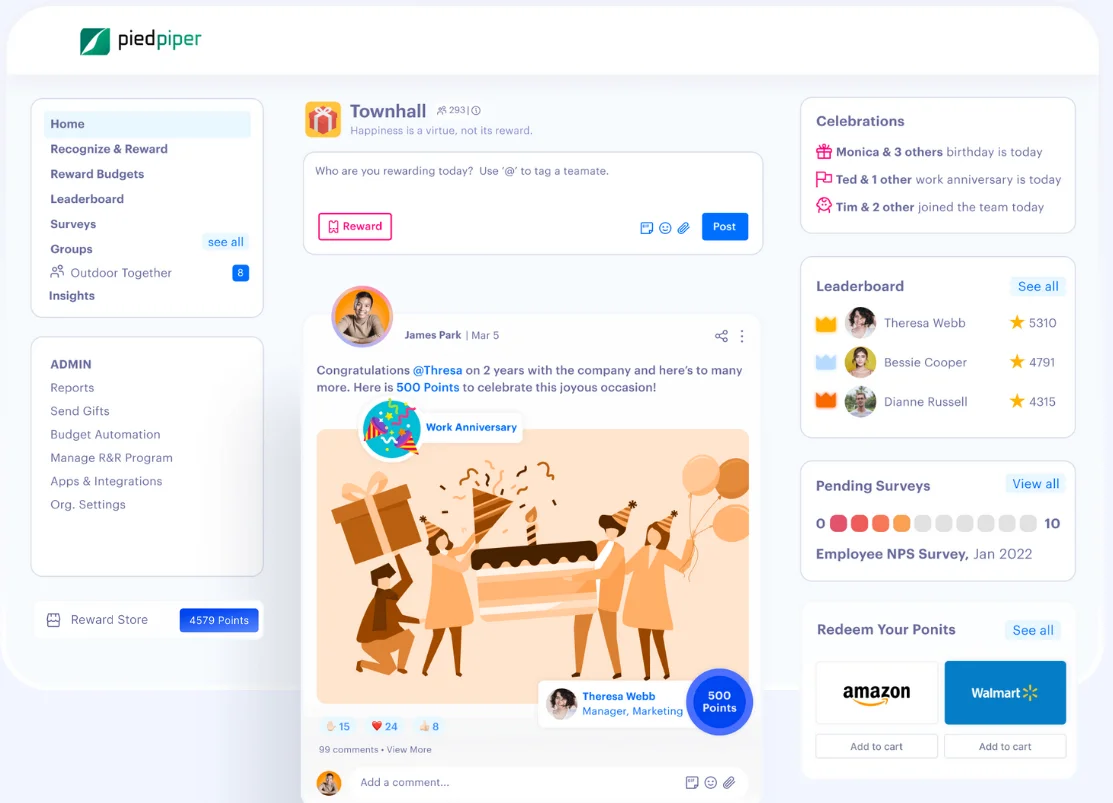Table of Contents
Motivation is a catalyst for better performance. In an organization, incentives motivate employees toward efficient performance. The sales team has a huge task of generating more prospects. Incentive pay is a big boost for them in this process. We will discuss incentive pay and how you can design a systematic pay program.
What is incentive pay?
Incentive pay is the additional, variable benefit sales team members earn apart from their regular salary. This is calculated in relation to their performance and contribution to business goals.
These incentives may be monetary or non-monetary. They may be distributed to all without any fixed criteria or to a specific member for meeting certain goals.
Should a business offer incentives? The following reveals the benefits of paying incentives to the sales team.
Benefits of offering incentive pay
Incentives are a win-win for both the employees and the business. Let us look at some of the benefits for the business.
1. Employee morale improves
The employees feel motivated when offered incentives in addition to their regular salary. They get more involved with their work and effectively contribute to the business goals.
2. Better relationships
The relationship between the staff and the management has to be harmonious. Incentives are one way to achieve harmony in the organization. The employees feel recognized and are able to communicate better with the leaders.
3. Reduces costs
Incentives are undoubtedly an additional cost to the company, but they also save a lot on frequent recruitment, training, etc. Employees stay longer and also show improvement in productivity, thereby saving huge costs to the company.
4. Reduces absenteeism
An uninterested employee may take frequent leaves. This affects the company and also increases its cost. Incentives reduce absenteeism by improving the morale of the staff.
Types of incentive pay
Incentives can be monetary or non-monetary. Here is a list of incentives offered to the employees to improve their morale.
Monetary incentives
Incentives, where the reward is in the form of money, are called monetary incentives. Let us take a look at some of them.
- Bonus: A yearly bonus is issued in many organizations. This is not linked to the performance but is given to all alike. This is over and above the regular monthly salary given to motivate employees.
- Profit sharing: Employees are given a bonus as a percentage of the total profits earned by the company. This entirely depends on the profits earned in a year. This annual payout depends on the company’s overall performance and not on any individual target achievement. If the profits are higher, the bonus also increases.
- Gain sharing: Gain sharing has an underlying condition. Here, the company expects the employees to achieve certain targets or fixes a performance criterion. When the same is achieved, the employees are paid a bonus. This should not be confused with profit sharing. The employees are paid bonuses relative to their performance only.
- Annual incentives: This annual payment is matched as a percentage of the employee’s salary. This lump sum is paid when the employees reach the targets set for them. It may or may not be paid in any particular year.
- Spot rewards: Rewarding on the spot is a strategy that goes well with the employees. Instant recognition without waiting for the year-end or completion of appraisal is a motivator for the employees. This can be monetary or non-monetary. As and when an employee achieves something special, he is recognized through spot rewards.
- Project bonus: This bonus category is given to a set of employees who work on a particular project. The project manager assesses each team member's contribution and determines the bonus on the successful completion of the project. The percentage of the bonus is fixed at the start of the project.
- Merit-based bonus: As the name indicates, this bonus is related to the performance of the employees. Every year, an appraisal is conducted, during which the team leader assesses the employee's contribution in relation to the goals and suggests areas for improvement. A fixed percentage of salary is paid as a bonus, which may vary between employees of the same project also.
- Referral bonus: Many organizations prefer to recruit staff through employee referrals. A referral drive is conducted every time there arises a vacancy. Employees are paid a bonus for every person they refer. Recruiting through referrals saves a lot of the organization’s money and effort. The company gives back to the staff in the form of bonuses.
Non-monetary incentives
Rewards other than in the form of money are non-monetary incentives.
- Paid vacations: Employees are given days off to enjoy a vacation but are still paid for those days. A fixed number of days every year are given as paid vacations so that the employees can relax and get back to work with motivation.
- Company outings: Companies arrange yearly outings for employees and their families. This means a lot to the employees and boosts their morale. This also helps establish better relations with the staff.
- Gift cards: Some companies give away gift cards for a specific sum so that the employees can use them for shopping. Instead of buying something that is the company’s choice, they prefer to leave the choice to the sales reps.
- Membership cards: Some companies gift their staff membership cards of gyms or health clubs. This indicates their interest in the well-being of the employees. For employees who often find themselves staying late, integrating rewards such as membership cards for pre-made single meal kits can offer a much-appreciated convenience that extends beyond the usual monetary incentives.
- Work-from-home days: This is a unique incentive that plays a great role in boosting the morale of the staff. Employees can pick certain days to work from their homes. This flexibility on the part of the company helps improve the productivity of the staff.
- Trophies: Deserving employees are presented with trophies for their contribution to the company’s growth. This motivates them to give more to the company. Annual events are conducted where trophies are distributed to the best performers of every team.
- Meal coupons: Companies give coupons that can be used instead of cash at restaurants. Employees attach more value to such perks rather than monetary payment.
- Entertainment coupons: Coupons that can be used instead of cash in theatres, malls, and other entertainment zones are also given by companies.
- Training programs: Training sessions that add value to an employee’s experience are thoughtful incentives. They help in career advancement and are welcomed by employees.
Selective employees who show exemplary performance improvements can be offered such incentives. This will motivate the other team members also to put in more effort to be eligible for such training sessions.
As we now know the types of rewards, let us move over to learn the steps in creating an incentive program.
How to create an incentive pay program
Every organization follows steps to create an incentive program for its employees. The following steps can help you create an incentive program.
1. Planning
Every successful implementation starts with a plan. An organization’s incentive program also needs proper planning to identify the types of incentives, the time for payment, and the criteria for choosing an employee. Planning helps the organization fix the budget for the same.
The plan should also be communicated to the sales team to enable them to contribute effectively. The role played by the individual members and the position in the team also play a role in deciding the type of incentive. Incentive planning should be flexible since several changes may arise in the business environment.
For example, changes in turnover, company policy, external factors, etc., may necessitate a change in the plan.
2. Monitoring
Constant monitoring is essential to keep the program up and running. Monitoring the plan helps leaders compare it with performance. The organization should identify if the sales team understands the plan. They should watch their performance to help them meet the requisite incentive criteria.
Monitoring brings to notice any lapses in the plan so that you can correct them instantly. Successful plan implementation needs the support of all team members, and monitoring helps achieve this.
3. Evaluation
Evaluation is also a part of creating an incentive program. Some organizations have mid-yearly reviews and give out incentives. Evaluation can be done after this period to determine if the program is ideal.
It helps analyze the team’s performance in relation to the plan.
Some of the questions you should ask at this step are:
- Was the program feasible?
- Did it allow enough freedom for the employees to work on the goals?
If the evaluation results indicate that the incentive program is going on smoothly, the same can be continued. If not, changes should be made to make the incentive program suitable for the employees and the business.
4. Optimization
The evaluation stage helps identify the best program for the organization. Incentives are not a one-time payout. It is a continuous process and may require revisions frequently.
Benchmarks for performance may become obsolete depending on circumstances. The company should arrive at an optimum plan program so as to be a rewarding offer to the employees.
Your business should identify and plug the gaps in the system if any. Optimizing the incentive program help in this process.
It is also important to learn how to create a good pay program. The below-mentioned tips can help!
How to develop a good employee incentive pay program?
Employee incentive programs are not one-size-fits-all. Every organization is different and needs a unique approach to designing the program. The broader types of incentives remain the same, but their applicability differs.
Some tips to help you develop a good incentive program are listed below.
1. Keep the program simple
A simple program makes implementation easy. The program should be easy to understand and follow the employees. Unrealistic incentive programs do not find favor with the team, and they would show indifference.
This brings down morale too, and can directly affect productivity. The targets should be specific and achievable. For example, each sales rep should reach a certain number of weekly orders to be eligible for incentives.
2. Goal alignment
Your program should be aligned with the goals of the organization. Every member of the team works towards the achievement of the common goal. The incentive program should not deviation from the goals as it may leave the team confused and uninterested. The employees will not be able to understand the direction of their efforts.
3. Consistency
Incentive programs should be consistent. The benchmarks should also be common for all the members of the team. Consistency of the program ensures that all employees are treated at par.
It also communicates to the team that a certain achievement will be rewarded. Random incentives to any particular member alone should be discouraged.
4. Options for rewards
You are rewarding your employees for their efforts, and it would be greatly appreciated if the choice of rewards is left to them. Rewards motivate people, but the types of rewards may differ. For example, an employee may opt for a cash reward instead of an entertainment coupon. Including this aspect in your incentive program can help boost its reach.
5. Communicate your program
Your sales team should know the incentives and their expected contribution. Only if they know what is expected of them they will work toward it. Official emails and other forms of communication should be directed to creating awareness. This will stimulate interest and lead the team toward achieving the goal.
6. Ask for feedback
You must hear the other side. Incentives are good motivators, but are your incentive programs properly planned and executed? You should seek feedback from the team to know the effectiveness of the incentive program.
With this, you can bring about improvements and also get to know the team's preferences.
Wrapping up
Incentive pay is a stimulant and motivates the sales team to contribute effectively. It is one of the best ways to get the employees closer to business goals. An incentive program should incorporate the above-mentioned points to be effective.
A good incentive program is beneficial for the organization as well as the employees. If you haven’t planned yours yet, remember the above points to implement a well-structured plan.




